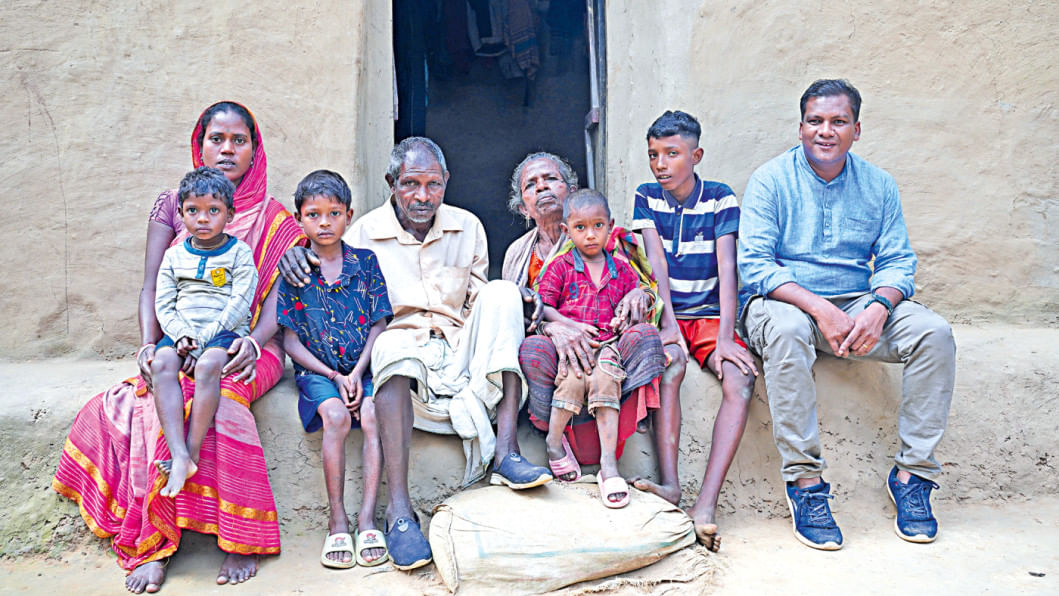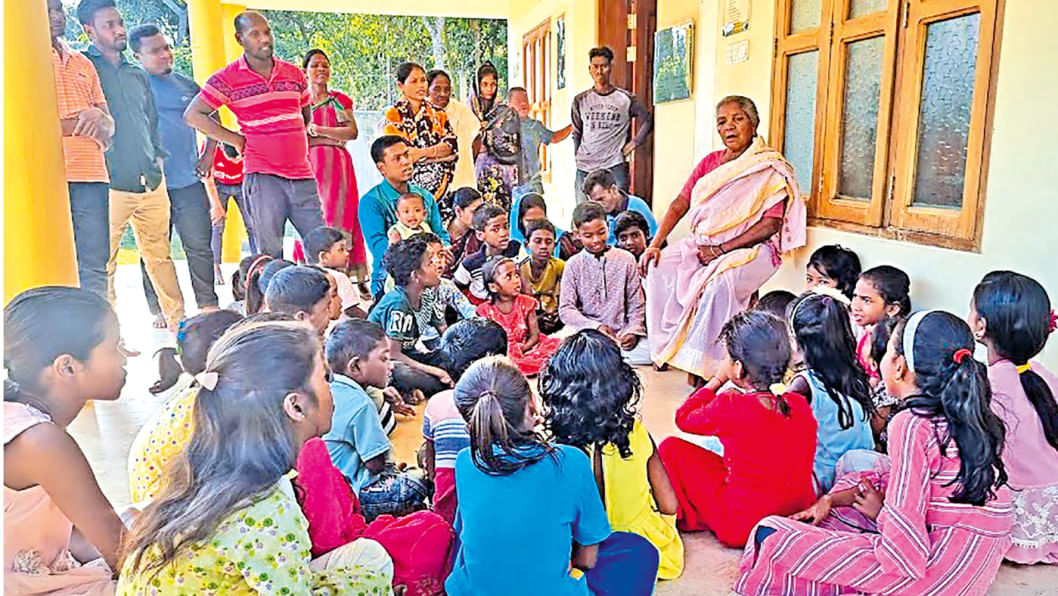In the heart of Moulvibazar's Sreemangal upazila, inside the Bormachhara Tea Garden, a language is quietly slipping into oblivion. Spoken now only by two elderly sisters, Veronica Kerketa and Christina Kerketa, the Kharia language—once a vibrant medium of cultural expression—is facing imminent extinction.
The sisters, who belong to the tea garden, are the last fluent speakers of Kharia in Bangladesh. A language once spoken by an entire community is now confined to their conversations after work, spoken softly over evening meals and during daily chores.
"If we two die, this language will die with us," said Veronica, the elder of the two. Her voice trembles with emotion, aware that their mother tongue might vanish from this land forever.
The sisters, seven years apart in age, learnt Kharia from their parents, who were brought from Ranchi, India, by British planters during colonial times to work in the tea gardens. Veronica, now retired, and Christina, still a daily wage worker, are widows and live in separate houses within the same village. But they meet often and speak only in Kharia to one another.
They are also fluent in Bangla and communicate with others in Sadri or Bagani when needed. However, none of their children or grandchildren speak the language. "I tried to teach them," said Veronica. "But they had no interest. They prefer Bangla."
Christina echoed her sister's concerns. "Once we're gone, no one will speak Kharia here anymore. The government must take steps now, or it will be too late."
"Only a handful of ten to fifteen people in Sreemangal can recall a few Kharia words," said Jaharlal Indwar Pandey, the head of the Kharia community in the area. "Our ancestors came from Ranchi to then Asam after 1884. They brought the language with them. Now, even though some of us can understand it, we don't know how to keep it alive."

Nestled in Bormachhara, the local Kharia community—just 24 families strong—comprises around a hundred people in total. But within this tight-knit group, the language that once bound generations together now lingers only in memory. There is no platform, curriculum, or organised effort to pass it on. No books, no schools, and no linguistic support. Without these, Kharia has steadily slipped away from daily life.
"Only my mother and aunt speak it," shared Hilarus Soreng, son of Veronica Kerketa. "When they talk to each other, the children laugh—they don't understand a word."
According to the International Mother Language Institute (IMLI), there are an estimated 4,000 to 5,000 Kharia speakers across Bangladesh. But on the ground, the reality appears much grimmer. Independent verification suggests only Veronica and Christina can speak it fluently.
Dr Mohammad Ashaduzzaman, Director of IMLI, acknowledged the urgency. "We are currently working on documentation and research on endangered languages, including Kharia, Kanda, and Rengmitchaya," he said. "Our team has already visited Sreemangal and plans to return. We're preparing proposals for the government and will hold regular awareness events and community discussions."
Despite this momentum, the absence of a structured education model continues to hinder progress. Dr Mashrur Imtiaz, Assistant Professor in the Department of Linguistics at Dhaka University, who conducted a field survey in 2018, estimated that fewer than 20 people in Sylhet still speak Kharia.
"I'm not aware of any institutional work or research on the Kharia language," he said. "There are no people who speak it, and no schools."
But there is a glimmer of hope. "I have a Kharia grammar book that I collected from India," Dr Imtiaz added. "Using this, a basic grammar can be developed for new learners so that the language can be preserved."
Pius Nanuar, a Kharia social activist who conducted a population study in early 2020, found around 5,700 Kharia individuals across 41 villages in Sylhet division. Despite recent government attention, tangible support remains limited. Visits from officials and IMLI signal growing awareness, but these gestures haven't yet translated into lasting initiatives.
What the community needs is simple yet vital—a language school with proper funding and resources. For now, the burden of preservation lies squarely on the Kharia people themselves.

Families try to pass down the language informally. Some even reach out to Kharia-speaking regions in India for materials. But these grassroots efforts, noble as they are, struggle without institutional backing.
Students from Jagannath University have created the docu-film The Last Leaf, focusing on the Kharia community of Bangladesh. With deep respect and authenticity, the film highlights the cultural richness, resilience, and challenges of the Kharia people. Director Shajnin Rahman emphasises the importance of preserving their language and culture, while Executive Producer Adnan Soykot underscores the power of storytelling to give voice to marginalised communities. The Last Leaf is a tribute to the dignity and heritage of the Kharia tribe.
Because Kharia is more than a means of communication. It is a vessel of the community's identity, history, and rituals. Letting it vanish would mean losing an entire heritage.
With sincere collaboration among the government, academia, and the Kharia community, there is still time to rescue the language—before its final echoes fade into silence.
Mintu Deshwara is a journalist at The Daily Star.


Comments